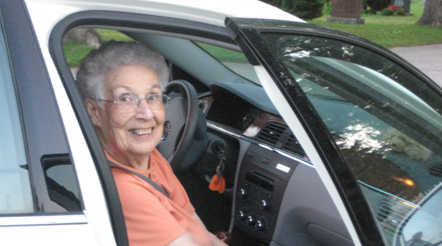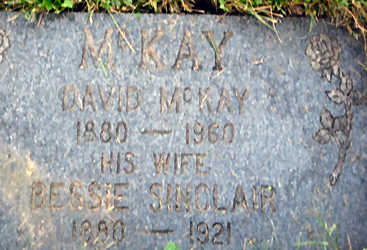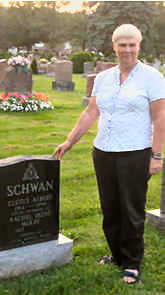|
Friends of
Fallbrook,
We trust
that, as true Celts, you have all taken the time to celebrate with our
Irish compatriots. After all, any pretext to eat, dance, drink and be
merry is our most sacred of traditions. It has now been proven
scientifically that the Presbyterian work ethic, taken to extremes as
Scots do with all things, can be harmful to one’s spiritual wellbeing!
As promised
in our last update, we are telling you about our Aunt Rachel Schwann-McKay.
She is the last person still living who actually lived on the farm with
the patriarch Donald McKay. Elders such as Wilma and Alma Sinclair lived
on neighboring farms and you will soon here of their stories. Mmes. Keir,
Gegghie and Gates maintained the heritage of Fallbrook until its last
gasp. They will be sharing their memories as well. We shall begin with
a text written by our resident historian, Joan. Along with a formal
presentation made by John and Irene Keir to Halton Hills Municipal
Council on December 7, 2007, it was these efforts following up on
intensive lobbying done by the McKay family which turned the tide
against demolition.

Aunt Rachel Schwan
Telephone interview conducted on Friday, Dec. 7th
2007
Rachel Schwan’s immediate family lived in Toronto until
she was 4 months old. Her brothers, Alexander & Malcolm were 3 & 7 years
old. At that time, the family moved to Owen Sound. (1917) Her father,
David (also k. as Donald) was a carpenter in a company making ice
refrigerators, first in Toronto than in Owen Sound where David became a
supervisor. They made storage units for meat, furs etc.
Her mother, Bessie Sinclair died when Rachel was 14 of
septicemia. Rachel’s aunt than was brought from Fallbrook to run the
family which now consisted of David, his two sons Malcolm and Kenneth
Alexander and Rachel. But after three years, dour David decided he no
longer wanted his sister. He put an end to Rachel’s schooling and she
took over keeping house for the men. She did finish grade 11. Her
brothers were away at University, (Malcolm becoming a lawyer and Kenneth
Alexander becoming a microbiologist-veterinarian.)

Both Bessie and David were buried in graves unmarked
until 1994. For reasons that we do not understand today, son Kenneth
Alexander only agreed to have a tombstone made when faced with his own
imminent death. Malcolm became crown prosecutor in Perry Sound but died
tragically at 32 years of age. The Sinclair’s are just learning about
their Aunt Bessie. We at Fallbrook would very much like to hear from
other Sinclairs. Below is Rachel’s daughter Linda, another of Donald
McKay’s great grandchildren beside her father’s Clete's grave.

In the summers, Rachel stayed at the farm near
Georgetown, with her grandfather Donald the patriarch. She remembers
well, details of the farm house at Fallbrook Farm. She told of the
beautiful creek that ran through the property. She remembered how the
creek had “steps” in it. (Could these have been cascades that may have
given rise to the name “Silver Creek?) The farm was about 150 acres at
that time. She mentioned the general nature of the farming that her
family practised,” grains, hens, some cattle and cows”. Presumably the
latter two refer to beef and dairy cattle. “They never made any money at
it,” she noted.
While staying at the farm, she visited with Oliver
Kirkwood, who had a cottage in the Forks of the Credit. She remembers
the quarries on the north side of the river, particularly the McQuaig
quarry. She told of hearing the blasting every year, and of seeing
trucks loaded with “pink” stone which was taken away to the “city”.
Pink sandstone and granite are abundant in this area, and it is
documented elsewhere (1) that the stone from the Forks of the Credit was
used to build the Ontario Legislature building at Queen’s Park in
Toronto. See the section below on the Kirkwood’s.
She remembers visiting in the summer, the hamlets of
Balinnafad, where the family attended the Presbyterian Church and where
David and William are buried, Erin, Acton and the Forks of the Credit.
These locations would have been within fairly easy reach of the farm.
She went to garden parties in Acton. Perhaps some of the visits had to
do with farm business? She did not mention what she did at the farm,
e.g. housework, gardening, cooking etc. These would have been usual
tasks for a young girl.
Rachel would travel from Owen Sound to Orangeville by
train. The whole trip by train from Owen Sound to Toronto would have
taken 4 hours. The old line stopped at many places en route, e.g. Forks
of the Credit, where there was hot food that could be purchased by train
passengers, by wiring ahead. The food was available in the station
house.
Once she reached Orangeville, Donald would pick her up in
his Model T Ford motor car.
(1) The Kirkwood’s are another branch of Donald McKay’s
family.
Jim Sr. ran the mill at Balinnafad. Son Jim jr. is a
founder of the Fallbrook founding board.
Mary McKay, Donald’s daughter, married William Kirkwood
of Erin. Her grandson, Bill, inherited the carpentry skills. He and his
wife Mary have retired to Trenton and their own log cabin in
Halliburton.
The Erin newspaper used to carry excerpts from the
Diaries of Bill (?) Kirkwood and I remember this. Rachel mentioned that
she believed that one of the Kirkwood’s ran the paper for a time.
In the book “The History of Peel County to mark its
Centenary as a separate County”, November 1967, one David Kirkwood is
listed as being the County Clerk from 1876-1918. p 133. (There is a
picture of him).
In the same publication, on p.67 there is an entry about
Hilda Kirkwood, a noted poet and journalist. She was one of a group of
Scottish and Irish pioneers from Peterborough County. She married John
Marlatt Kirkwood, a descendant of the UEL and Peel pioneers.
Note: Rachel is 92(August 10) years old. She is bright,
well spoken, and leads an active social life. She admits to a few lapses
of memory, but so do I.
The above is what I gleaned from my talk with her.
Persons interested in contacting Aunt Rachel can do so through us at our
website fallbrook at
live.ca
N.B. Text in italics were added after revision with Aunt
Rachel and written by Sandy McKay
IMPORTANT- IF YOU ARE A RESIDENT OF BALLINAFAD, PAST OR
PRESENT, AND YOU HAVE YOUR OWN STORIES TO TELL, PLEASE SEND THEM TO US
WITH PRESCANNED PICTURES . WE WOULD BE THRILLED TO WORK WITH ALASTAIR AT
ELECTRIC SCOTLAND TO INCORPORATE THEM INTO THE FALLBROOK SAGA AND TO BE
SURE THAT THEY BE PART OF THE UNIVERSITY OF GUELPH ARCHIVES.
Although nothing is official or written in black and
white, the Credit Valley Authority is meeting with us since December
2008. It would seem that they have accepted the inevitability of
preserving such a rich heritage cultural site. Will their proposal
respect the Murison report and probably the same proposition from the
Heritage Hills Heritage Committee (The complete heritage report is not
yet available but you will see the preliminary report in the next
update)! Will they work in collaboration with Friends in a partnership
in conceiving, raising funding and managing the resurrected site! As
requested, we have removed from our website (Google Fallbrook Farm) the
criticisms erred in our first reports based on their unchanged request
for a permit to demolish. The CVA team is preparing a modus Vivendi (a
process), to govern their relations with community heritage groups like
ours!! We have been told to wait that this procedure becomes law.
Meanwhile, the homestead deteriorates and the neighbours complain. Our
own land’s manager and Fallbrook farmer, Wayne Gates has requested
permission to do a spring clean-up in May. We await an answer.
The new spring shall
bring flowers to Fallbrook.
DISCLAIMER- The views expressed are those of the authors
and do not necessarily reflect the editorial policy of electricscotland
or the official position of the Friends of Fallbrook
COPYRIGHT- the Murison report as well as photos used on
the site are under copyright and can only be reproduced with permissions
from the authors.
For approval, contact us. Merci
The Case for the preservation of the property known as
the Falling Brook Farm.
In the early 1800’s migration to Canada reached a peak.
Poverty in the British Isles was at critical heights. The resources of
the churches, which had traditionally taken care of those too poor to
look after themselves and their families, were stretched to the limit.
In desperation they turned to the governments for help. The Canada
Company was formed to expedite the emigration of the indigents to
Canada. This migration was to solve several challenges facing the
government at Westminster.
Upper Canada was vulnerable from attack from the south,
and needed to increase its population. The British were always wary of
the Catholic Church and the French influence in Lower Canada. The
migration of Scottish, Irish and English to Ontario was intended to
maintain a balance, and ease the burden on the churches in the homeland.
Free land was made available in designated areas, together with options
to buy more. Tools, seed and some animals also were available.
Immigrants left the privation of the British Isles for the equally
arduous conditions of scratching a livelihood in Canada.
They were faced with the most horrendous conditions
aboard the sailing ships that took as much as eleven weeks to cross the
Atlantic.
On arrival in Upper Canada they were allotted land and
had to make their way to it. It was these immigrants that populated,
cleared and tilled the lands of Ontario, and made way for those of us to
come later.
Life was very lonely and hard, and few records remain,
since many of the immigrants were illiterate. For us and for our
children, it is very difficult to imagine what these early settlers went
through. For every immigrant, there were the piercing ache of
homesickness, the doubts, and the failures. Here in Halton Hills, at the
Falling Brook farm we have a chance to preserve the history of these
struggles, and the people who settled here. We have their names, but
individually they are as one among many thousands, but they are not
insignificant. They as a community offer a unique opportunity to
demonstrate how early immigrants lived, died, failed, thrived and
prospered.
Here we can see the log house, purchased by the patriarch
Donald McKay in 1877 which was added to over the years as needs demanded
and funds were available. Through oral history collections we have
pieced together a fascinating story of the common people. Throughout
Ontario, many persons of renown have been recognize by the naming of
streets, highways, buildings and even communities in their honour.
Some are born to renown, and are rewarded. Some achieve renown through
their acts &/or talents, and are celebrated. And others have renown
thrust upon them by their descendants, who, looking back at the
hardships that were endured on their behalf by their ancestors,
remember, with gratitude and acknowledgement.
As an immigrant, as a historian, and as a collector of
oral histories, I support the families of Silver Creek settlement area,
and ask you to reject the proposal to destroy the home at Falling Brook
Farm. I also request that investigations be undertaken to preserve this
unique situation, and make not only the home, but the artifacts that
were there, and the historical documentation that is ongoing available
for educational purposes. It is a prime opportunity to provide for the
children of this region to learn from this settlement. Funds can be
found through school trips and public exhibitions etc. to help with the
costs of up keep. Funding through government sources is also possible.
Let us remember the sacrifices these settlers made, and
publicly acknowledge them. |

